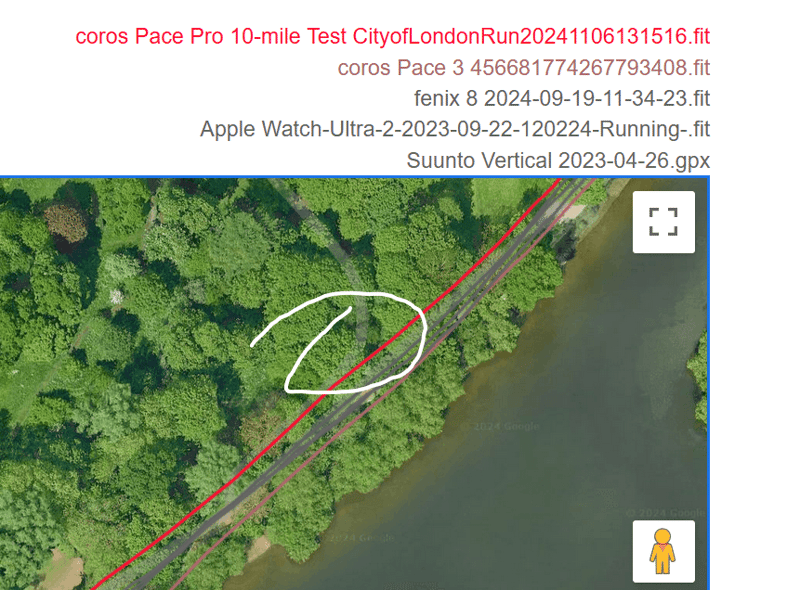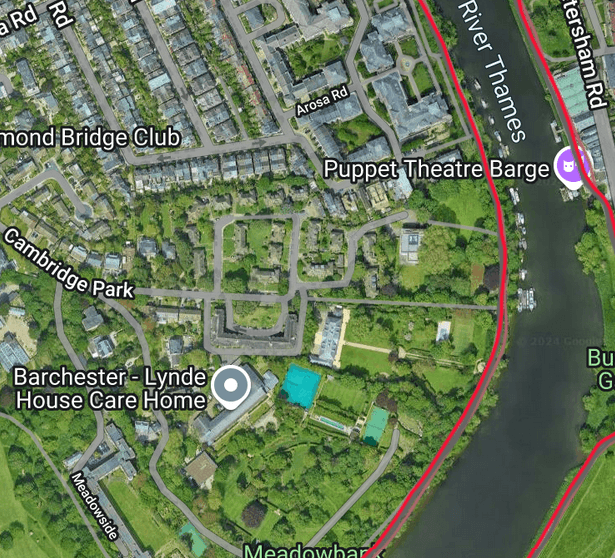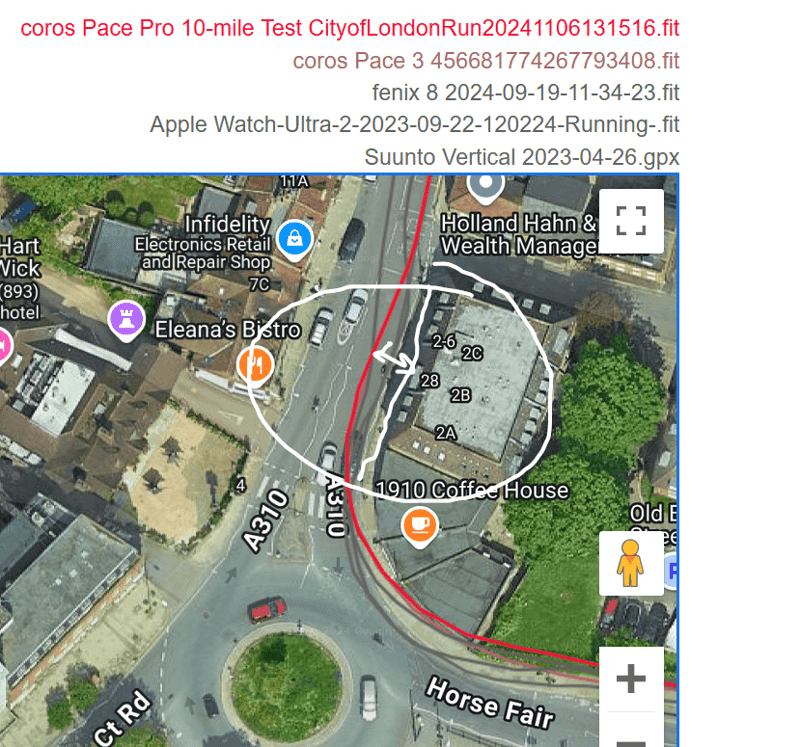 Coros Pace Pro – GNSS Accuracy Test
Coros Pace Pro – GNSS Accuracy Test
The results in this article are from a single GPS/GNSS accuracy test on the Coros Pace Pro using a standard methodology I’ve applied to almost every sports watch produced in the last decade. Obviously, I also perform other kinds of extensive GPS tests. This particular test interests me as I score watches on an almost like-for-like basis, and the test conditions over 10 miles represent many real-world conditions you’ll encounter. It’s a good test.
I used to record DOP/HDOP/VDOP and satellite availability, but that factor is no longer an issue in determining the accuracy of modern watches. Whilst satellite availability does vary minute-by-minute, multi-constellation watches now have tens of satellites to choose from – there used to be issues linked to occasionally, say, only having 6 GPS satellites available.
The test uses the first production firmware, ie v3.0708.0 (GPS: v165.20.24-8178). For comparison, the PACE 3 GPS test I performed a year ago used v3.11 GPS3.0.3. This confirms that a different Airoha chipset or algorithm is used in the Pace PRO.
Buy Coros Pace Pro: USA – $349, UK – £349, EU – 399€
Test Results
Distance: The distance recorded was exactly 100% of the median distance of all tests. All that means is the over- and under-recording at specific points on the route perfectly cancel each other out.
Pace: The responsiveness to instant pace displayed live on the watch was 12 seconds. That sounds bad, but other watches can be over 30 seconds, so it’s OK but not as good as the true near-real-time from a footpod like Stryd.
The high-level overview of the route looks as good as all the best previous tracks, and all appear to follow my actual route perfectly. For your pretty track on Strava, almost all sports watches are OK. Pace Pro is no exception.

I use the satellite image as the human-made map can sometimes put trails and roads in the wrong place, especially if there is tree cover. Indeed that IS the case on this route.
Points of Interest
As shown in the image below, I run a sharp bend near a building in Twickenham, home of World Rugby and the Cabbage Patch 10-miler, then under a shop’s awning. Pace Pro was relatively poor here, taking over 30 metres to recover to a more accurate position toward the bottom of the image. In the lead-in to this section where satellite reception was Ok, Pace Pro started to falter.
Again, this next section is poor, where I run in the middle of a minor road with 3-metre walls on either side and tree cover in places. Watches are usually better than this, and I consider errors of over 5m poor.
Next is a gently curving riverside path under tall, relatively dense tree cover. Zoomed out, Coros seems OK, but when zoomed in a little, it’s not quite as good as I’d like.
Crossing Richmond Bridge gives a clear sky for PACE to ready itself for a tricky loop down steps and back under the bridge. As you can see, something weird happens on the easy bit before turning right and running next to a wall where, surprisingly, it’s OK.
We are now on the rather pretty Richmond Riverside, next to Elon Musk’s old PayPal offices and tens of metres away from Ted Lasso country. I loop around a tree at the top of the image, but had I continued for 40 metres; I would be at the site of the old Royal Palace of Richmond where Queen Elizabeth the First waited anxiously for the Armada to be defeated (or not…it was…she lived). The point of the GPS track’s precision here is not to cross over the outward track on the return leg. Pace Pro does do this slightly, but it’s OK. It then has to return under Richmond Bridge, which it does by taking the leftmost tunnel. It did well here. History lesson over.
 Next comes a straightforward section where Coros Pace Pro should excel…and does excel. Running past Petersham Meadow, you may see some cows grazing and, in the distance beyond them, Petersham nurseries, where the Richmonderatti go to buy overpriced objects for their gardens or very overrated food (in my experience), albeit in a lovely setting.
Next comes a straightforward section where Coros Pace Pro should excel…and does excel. Running past Petersham Meadow, you may see some cows grazing and, in the distance beyond them, Petersham nurseries, where the Richmonderatti go to buy overpriced objects for their gardens or very overrated food (in my experience), albeit in a lovely setting.
Next is an avenue of trees next to the German School and Ham Polo Club. If you want your kids to be educated alongside all the German kids in SW London, this is the place to go. If not, you can watch grown men and women playing hockey (polo) on horseback. I was once chased by a badger here at night; luckily, I was much quicker.
Even though it’s imperfect, I’d give Pace PRO full marks here.
Then we come to Cut Throat Alley. You can probably guess why it was called that, but, like me, your guess would be wrong as its name is a corruption of Cut THROUGH Alley, where historically, the farm workers could cut through the Ham House lands and avoid a detour. Anyway, I chose this alley over a decade ago for the route as I was convinced no GPS device would ever get it right. In more recent years, they have started to nail it. Pace Pro doesn’t quite nail the second part of the alley, but I’ll be generous and give it full marks, knowing that it has already slipped up on more manageable sections elsewhere so that the overall score won’t be too severely impacted.
The sweeping curve of Riverside Drive shouldn’t be hard for watches to perfect. Often, watches used to struggle with long curves, but Pace Pro nails this, as it should.
 Oddly, Coros nails the next more difficult piece on the trail under the trees but is slightly out in the easier, more open section that immediately follows. I’ll have to dock a mark here. Very strange.
Oddly, Coros nails the next more difficult piece on the trail under the trees but is slightly out in the easier, more open section that immediately follows. I’ll have to dock a mark here. Very strange.
The following section shows a good performance under some quite serious tree cover.
This section is impossibly hard. I run under an awning next to a tall building with other tall buildings on the other side of the road. After a 90-degree turn, I ran very close to the multi-story John Lewis building and almost made a 180-degree turn close to the same building and into a tunnel under it. The tunnel has no GPS reception and must be 60 or 70 metres long. So the test here is many-fold: to see how reflected signals are handled off tall buildings and if the accelerometer can make any sense of a lack of signal. After the tunnel, we see how quickly the watch can recover to the correct position. From memory, only one watch ever fluked this section. As I was lenient in the previous section, I’ll have to score harshly here as the track doesn’t look good.
The final section I score on is almost 4km long and represents easy suburban running. I expect a perfect score here but surprisingly rarely get an ideal track; often, for no reason, watches show me running on the wrong side of the road – i.e. an error of over 5m. Coros does NOT do that and produces a great track except at the start of the section, with some close buildings to navigate. This section is near the well-known Sigma Sports bike store and reliably indicates how dual-frequency chipsets handle (or not) reflected signals. The whole point of the dual-frequency chipsets that the brands sell you at premium prices is that the two frequencies produce two paths that should be identical. If they are not the same, the watch should discard that particular signal as it has either been reflected or refracted, which means it’s giving an incorrect reading. It is VERY CLEAR to me that MANY dual-frequency chipsets are not presently doing that. Coros is doing better than most here. It’s not perfect, but it’s pretty good. You can see some of the other greyed tracks from leading watches on the same image and how they veer into the road. However, even doing the max zoom-in on the bottom corner, you can still see an error of 2-3m – as of 2024, I think this is as good as you can expect.
Take out
Coros Pace Pro scored a creditable 81% compared to Coros Pace 3, which scored 92% – the latter is the joint best-ever result. Pace Pro’s score oddly suffered in the medium-difficulty sections of my test.
Other reviewers have commented that Pace Pro has improved accuracy over Pace 3. It hasn’t; perhaps Coros is still bedding in a new GPS chipset. Another reviewer (I can’t recall which) also said that a post-launch firmware change lowered the GPS accuracy.
This sounds odd to me. Whilst the antenna and algorithms are essential to accuracy, the power available to the chip is also an important factor in realising precision capabilities. I genuinely hope Coros is not guilty of forcing more power through the firmware some reviewers received to fool them into reporting high accuracy levels before launch. Later, the power and quality is lowered to boost battery life – the feature most customers seem to care about.
Anyway. I can only test what I have when I have it. My whole suite of GPS and HR tests is far from trivial to complete. Testing the watches on every firmware version would be a full-time job if every brand changed firmware after my test results were initially published. Brands need to get accuracy and key features working before launch. It’s odd that I even need to say that.
I’ll ask Coros to comment below if they want to, or anyone else is free to comment on their behalf.
Buy Coros Pace Pro: USA – $349, UK – £349, EU – 399€
 Coros Pace Pro – GNSS Accuracy Test
Coros Pace Pro – GNSS Accuracy Test














There’s a bug on the new GNSS chipset and they’ve turning off the RTO, which can affect overall accuracy. Why can’t you hold your reviews until Coros enable it? Or because of your traffic thirst, like how you leaked and spoil the Pace pro before the launch?
FYI There’s a bug on the new GNSS chipset and they’ve turning off the RTO, which can affect overall accuracy. Why can’t you hold your reviews until Coros enable it? Or because of your traffic thirst, like how you leaked and spoil the Pace pro before the launch?
Why can’t Coros hold the launch until the product is ready to be sold? It seems odd to ask me again to hold back on my content about a product that is actively being sold and taking money from consumers.
Coros did the same for DURA in their thirst for sales. ie releasing a product before it was ready. Very sloppy. Garmin can get away with a few bugs, a small company like Coros will have problems if they keep releasing products that are not ready.
Perhaps Coros could be organised enough to control its information flow to its retailers. Coros chose to tease its product and then it was two (or three) of its retailers who leaked the product details, that spoiled the launch once the people on Reddit got hold of the info. Do your research.
When it comes to traffic I’m afraid you don’t know what you are talking about. Traffic from a peripheral, challenger brand like Coros is very small and insignificant in any sense – money, volume, importantce…choose your metric.
Furthermore I have ads turned off for the main post on the Coros Pace 3…I get no money from ads on that article. Do your research.
Your response read quite unprofessional and only serves to lose readers. A better way would have been to share in the article that the GNSS results of the Pace Pro maybe skewed due to the current firmware impairment and that a retest would occur once Coros releases a fix.
[edited: personal comments removed]
thank you for your comment, I will address its factual inaccuracies.
I can confirm that my site traffic is up this year by 25% and that this post on the Pace Pro is a top-ranking result on google search. so I certainly am not losing readers as you suggest, quite the contrary.
Coros have failed to reach out to me with any comment over changes to how they handle their GPS chip. Would you call that professional on the part of Coros?
in the absence of an official comment, i specifically did include 2nd hand information about the chipset to help readers make informed decisions:
“…perhaps Coros is still bedding in a new GPS chipset. Another reviewer (I can’t recall which) also said that a post-launch firmware change lowered the GPS accuracy.”
and i point out the obvious, that companies need to get products right before they release them with bugs to the potential customers whose money they want. I have been similarly critical of Garmin on this same issue.
“Testing the watches on every firmware version would be a full-time job if every brand changed firmware after my test results were initially published. Brands need to get accuracy and key features working before launch. It’s odd that I even need to say that.”
ACTUAL ACCURACY:
I’m not entirely sure what you are complaining about as the the Pace Pro is relatively accurate:
as i said above: “Coros Pace Pro scored a creditable 81% compared to Coros Pace 3, which scored 92% – the latter is the joint best-ever result.”
furthermore, in the absence of communication from Coros, I checked the official coros firmware page; https://support.coros.com/hc/en-us/categories/4416357319956-Software-Updates. it mentions no fix to GNSS chipset issues.
so, I can only assume that were I to repeat the test now, the result would be similar. But I don’t really know as coros’ firmware updates page appears to be incomplete and inaccurate.
Totally unrelated:
I understand that you want to earn some money with your blog.
But that reminder pop up to either disable add blocker or subscribe is a bit to much.
That pop up pooping when you enter the log in page is a joke.
ty @Bene
There should be ZERO pop-ups, **if you could let me know where they happen that would be great** (eg I don’t do any kind of annoying ‘subscribe to my newletter’ popups). I vaguely recall playing with an option to turn off one of the ‘disable/subscribe’ message when I enabled something else. Perhaps I made a mistake there and left something turned on? It might be hard for you to reproduce it as some of these kinds of events, once triggered, then don’t re-trigger for quite some time.
there are vignette & interstitial ads (https://en.ryte.com/wiki/Interstitial/ ) which I dont want to remove. These bear some resemblence to popups but are different.
“Another reviewer (I can’t recall which) also said that a post-launch firmware change lowered the GPS accuracy. This sounds odd to me.”
I noted it in my review. Essentially, due to the GPS battery burn issues I ran into, in the final production firmware launch, COROS had to disable pieces that handle satellite error correction. This fixed the extremely high battery burn issues I was seeing (10%/hour), but until they release the updated GPS chipset firmware, will have lower accuracy in areas that dual-frequency normally would have taken care of.
COROS says this will happen in a matter of days, though, it’s been a week already.
thanks Ray.
“will have lower accuracy in areas that dual-frequency normally would have taken care of” from this test, that is not what I found. As noted above, the dual frequency error correction appears to work better than many other devices in areas of tricky reception. It could definitely be even better in those scenarios and if Coros can nail that it would be impressive. I have other planned tests that specifically look at dual frequency in more detail and no plans to do them for at least a week or so. let’s hope Coros get their fingers out and fix whatever needs fixing before then. Coros seemed to be lacking in accuracy in areas where dual frequency shouldn’t have made much, if any, difference.
It’s possible that the battery burn issue is/was intentional, to increase GPS accuracy.
Great test. And very real world for most of us. No gps can be perfect so the objective analysis is welcome.
By the way, how did the Vertical fare on this test in the tunnel? Being a Suunto user Id be interested to hear how fusedtrack handled (or not) that section and the test overall.
Keep up the good work 👍
https://the5krunner.com/2016/11/05/test-route-for-gps-devices/
that link will point you to a spreadsheet with all the devices on and there scores for each section. The tunnel section is the second to last scoring column.